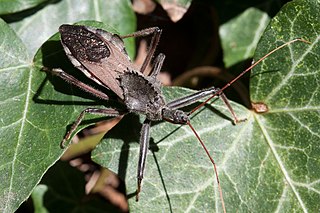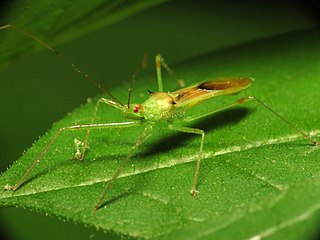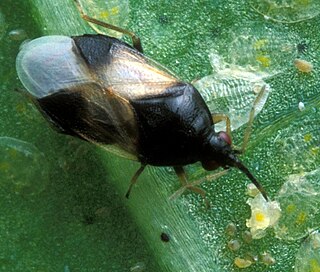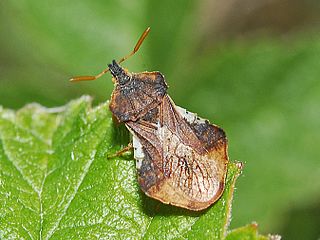
Hemiptera is an order of insects, commonly called true bugs, comprising over 80,000 species within groups such as the cicadas, aphids, planthoppers, leafhoppers, assassin bugs, bed bugs, and shield bugs. They range in size from 1 mm (0.04 in) to around 15 cm (6 in), and share a common arrangement of piercing-sucking mouthparts. The name "true bugs" is often limited to the suborder Heteroptera.

Parasteatoda tepidariorum, the common house spider or American house spider, is a spider species of the genus Parasteatoda with a cosmopolitan distribution. Common house spiders are synanthropic and live in and near human dwellings. Their prey mechanism is similar to that of the other cobweb spiders: the spider follows disturbances transmitted along the web to entangle and then paralyze its prey, which usually consists of household insects and other invertebrates.

The Reduviidae is a large cosmopolitan family of the suborder Heteroptera of the order Hemiptera. Among the Hemiptera and together with the Nabidae almost all species are terrestrial ambush predators; most other predatory Hemiptera are aquatic. The main examples of nonpredatory Reduviidae are some blood-sucking ectoparasites in the subfamily Triatominae. Though spectacular exceptions are known, most members of the family are fairly easily recognizable; they have a relatively narrow neck, sturdy build, and a formidable curved proboscis. Large specimens should be handled with caution, if at all, because they sometimes defend themselves with a very painful stab from the proboscis.

Arilus cristatus, also known as the North American wheel bug or simply wheel bug, is a species of large assassin bug in the family Reduviidae and the only species of wheel bug found in the United States. It is one of the largest terrestrial true bugs in North America, reaching up to 1.5 inches (38 mm) in length in its adult stage. It is sexually dimorphic, in that males are somewhat smaller than the females. A characteristic structure is the wheel-shaped pronotal armor. North American wheel bugs prey on caterpillars and beetles, such as Japanese beetles, the cabbage worm, orange dogs, tent caterpillars, and the Mexican bean beetle, all of which they pierce with their beak to inject salivary fluids that dissolve soft tissue. The North American wheel bug is most active in daylight, but may engage in predatory behaviors at night in areas illuminated by lights. Because most of its prey are pests, the wheel bug is considered beneficial.

Peucetia viridans, the green lynx spider, is a bright-green lynx spider usually found on green plants. It is the largest North American species in the family Oxyopidae. This spider is common in the southern U.S., Mexico, Central America, and in many West Indies islands, especially Jamaica. Lynx spiders are hunters specialized for living on plants. This species does not use a web to capture its prey. It pounces on its prey in a cat-like manner, which is the reason for the name lynx. It is active during the day.

Zelus luridus, also known as the pale green assassin bug, is a species of assassin bug native to North America. It is the most common Zelus species in the eastern United States. The size ranges from 12.5 to 18 millimetres long. On average, adult females are 16 millimetres (0.63 in) long, while males are 14 millimetres (0.55 in) long. Though the base color is pale green, markings on the back can range from dark brown or red to bright yellow. Nymphs are generally more solid green, wingless, and with narrower bodies than adults. The most reliable feature to distinguish this species from others is the pair of spines on the rear corners of the pronotum. These spines are long on the lighter colored individuals and shorter on ones that are darker. It can also be distinguished by dark bands on the distal ends of the femurs, but these can often be too light to be easily seen. The egg masses, which are laid from late June to August, are conical in shape with a flat top. They are laid on leaves in groups of twenty to fifty and held together with a sticky, brownish material. Their bite is extremely painful.

Sinea is a New World genus of assassin bugs, in the subfamily Harpactorinae. 13 species have been described, mostly from the Southwestern United States and Central America.

Mantises are an order (Mantodea) of insects that contains over 2,400 species in about 460 genera in 33 families. The largest family is the Mantidae ("mantids"). Mantises are distributed worldwide in temperate and tropical habitats. They have triangular heads with bulging eyes supported on flexible necks. Their elongated bodies may or may not have wings, but all Mantodea have forelegs that are greatly enlarged and adapted for catching and gripping prey; their upright posture, while remaining stationary with forearms folded, has led to the common name praying mantis.

Orius insidiosus, common name the insidious flower bug, is a species of minute pirate bug, a predatory insect in the order Hemiptera. They are considered beneficial, as they feed on small pest arthropods and their eggs. They are mass-reared for use in the biological control of thrips.

Zelus renardii, commonly known as the leaf hopper assassin bug, is a predacious insect contained within tribe Harpactorini. Diurnal and found on both wild and crop plants, Z. renardii has spread from its native habitats in western North and Central America into three other biogeographic regions across the globe.

Phymata crassipes is a species of assassin and thread-legged bugs belonging to the family Reduviidae, subfamily Phymatinae.

Tessaratomidae is a family of true bugs. It contains about 240 species of large bugs divided into 3 subfamilies and 56 genera.

Gratiana boliviana is a species of beetle in the leaf beetle family, Chrysomelidae. Its common name is tropical soda apple leaf beetle. It is native to South America, where its distribution includes Argentina, Brazil, and Paraguay. It specializes on tropical soda apple, an invasive plant species. It has been released as an agent of biological pest control against the weedy plant in Florida and other parts of the United States.

Euthyrhynchus floridanus, the Florida predatory stink bug, is a species of carnivorous shield bug in the family Pentatomidae, the only species in the genus Euthyrhynchus. It is native to the hottest parts of the southeastern United States and is considered beneficial because it feeds on many species of pest insects. They also feed on things such as grasshoppers and other small insects. This species also hunts in a pack, with up to twelve.
Sinea rileyi is a species of assassin bug in the family Reduviidae. It is found in Europe and Northern Asia and North America.
Sinea anacantha is a species of assassin bug in the family Reduviidae. It is found in North America.

Sinea coronata is a species of assassin bug in the family Reduviidae. It is found in the Caribbean Sea, Central America, and North America.
Rhynocoris longifrons is a species of assassin bug in the family Reduviidae. It is a predator of other insects and is found in Asia. Crops on which it is found feeding on pests include pigeon pea, cardamom and peanuts. The insects are potentially useful in biological control because they are more resistant to pesticides than are the pests they consume.
Rhynocoris marginatus is a species of assassin bug in the family Reduviidae. It is a predator of other insects and is found in Asia. Crops in India on which it has been found feeding on pests include sugarcane, pigeon pea, cardamom, cotton, tea, and peanuts. The insects are potentially useful in biological control because they are more resistant to pesticides than are the pests on which they feed.

Acanthaspis quinquespinosa is a species of assassin bug found in India, Sri Lanka, Myanmar, Nepal and Tibet. It is a predator, and both nymphs and adults feed on termites, beetles, caterpillars and other insect prey.















